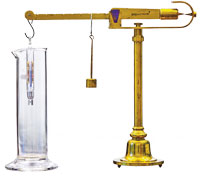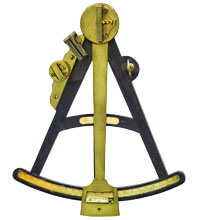From the Archives: Early Measures
Computers, lasers, and other advanced tools for taking measurements have improved accuracy and pushed the boundaries of knowledge. While early devices have mostly become museum artifacts, their beauty and handcrafted details remain admirable, as evidenced in these examples from the Department of Physics museum.

A ship’s clock, or marine chronometer, measures the time of a known fixed location, for example Greenwich Mean Time (GMT). Knowing GMT at local noon allows a navigator to use the time difference between the ship’s position and the Greenwich Meridian to determine the ship’s longitude. These clocks, developed in the late 1700s, featured detached spring detent escapements, temperature compensation on the balance, and balance springs, which made it possible to measure time accurately at sea. This brass model no. 617 made by Kline & Company, New York, dates from the early 1800s.

This brass equal arm analytical balance, housed in a cherry case, includes a chainomatic mechanism capable of achieving microgram precision. This feature was patented in 1916 by manufacturer Christian Becker Inc. of New York.

A hydrostatic balance is used for finding the weight of an object submerged in water in order to determine its specific gravity. This 19th-century solid brass instrument with glass hydrometer was made in Germany.

An octant, also called a refl ecting quadrant, uses a small mirror to bring two images together, such as the sun and the horizon, for instance, to determine latitude at sea. It has an arc of 45 degrees or more that measures angles up to 90 degrees. Invented in the early 18th century, octants were usually made of brass and mahogany, such as this example.

The 1860 observatory clock, made by E. Howard & Co., Boston, Mass., was housed in the Traill Green Observatory, which stood from 1864 to 1914 on the Colton Chapel site and then was moved to the site where Markle Hall now stands. The hand-painted dial displays hours, minutes, and seconds. The pendulum has vials of mercury (now sealed) that adjust for changes in temperature. In 1929 when the observatory was torn down, the stones were used to build the archway at the steps leading up to the College from Third Street.
Known as the “Star Barn,” the observatory was built by faculty member and trustee Dr. Traill Green to house a telescope he had donated. James H. Coffin, who came to Lafayette in 1846, was also instrumental in establishing the observatory. Professor of mathematics, natural philosophy, and astronomy, he collaborated with the newly established Smithsonian Institution, tabulating data on the motion of winds. His pioneer work in the field, Winds of the Northern Hemisphere, was published by the Smithsonian in 1853. The British Admiralty adopted Coffin’s records of the winds as a guide to British shipping on all seas. The wooden base of Coffin’s self-registering anemometer is in the Smithsonian Museum’s collection of early scientific equipment. His papers (1829-1911) are housed in the College’s Special Collections, Skillman Library.